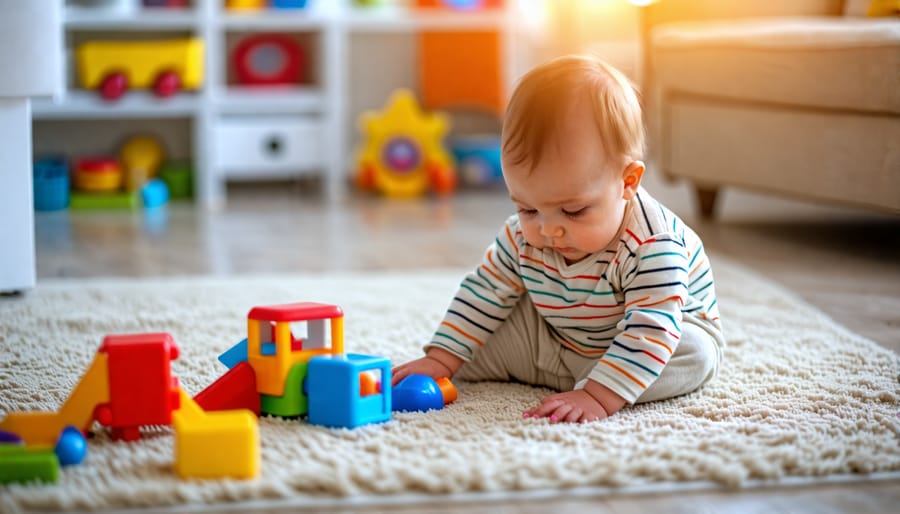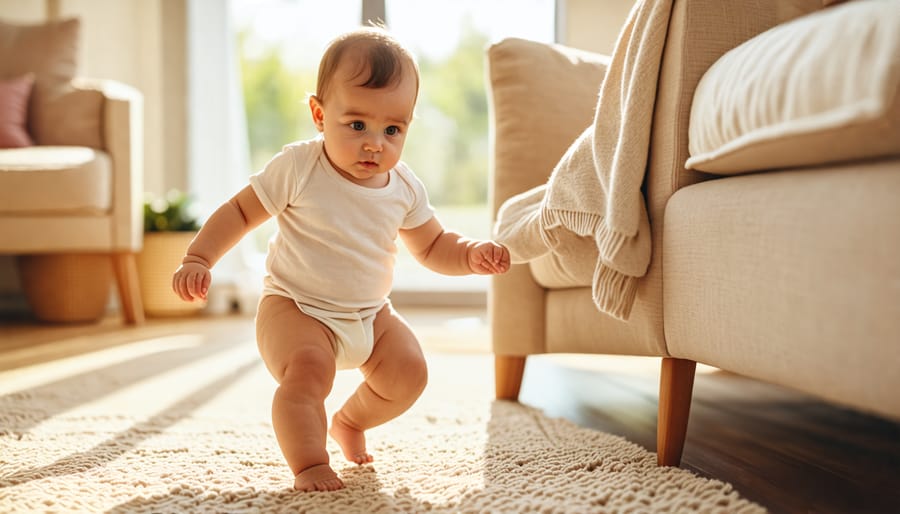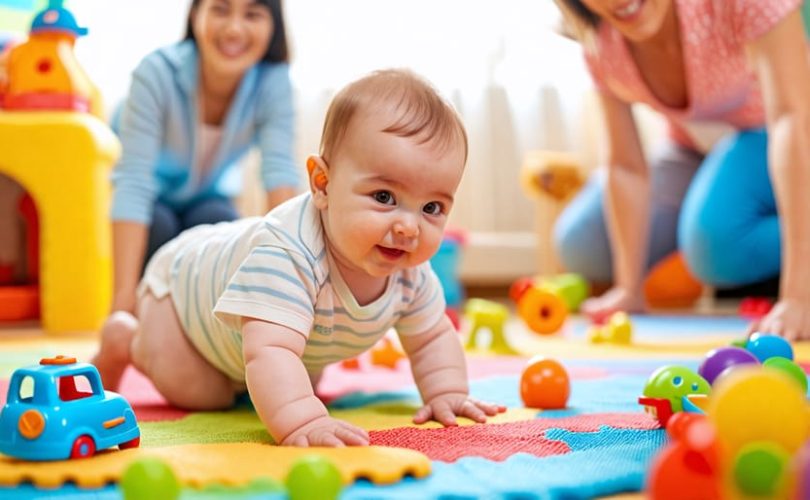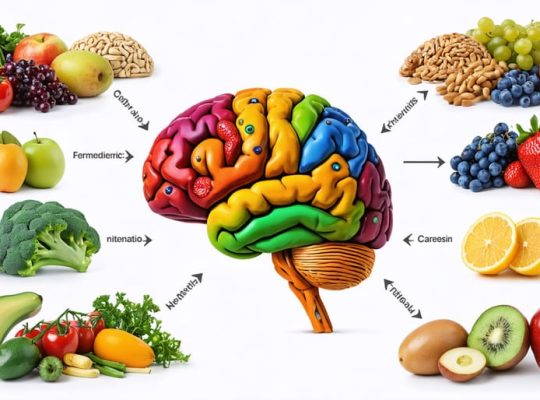Encourage tummy time starting from birth to strengthen neck, shoulder, and arm muscles. Place baby on their tummy for short periods several times a day, increasing duration as they grow.
Facilitate reaching and grasping by offering colorful, safe toys just out of baby’s reach during tummy time and while sitting supported. This develops hand-eye coordination and fine motor skills.
Promote crawling and cruising by creating safe, open spaces for exploration. Place toys at different distances and heights to motivate movement. Sturdy furniture can support pulling up and sideways walking.
Engage in interactive play like peek-a-boo, patty-cake, and gentle bouncing games. These activities enhance social-emotional development, body awareness, and balance while strengthening the parent-child bond.
Benefits of Physical Activity for Infants
Physical activity is essential for your baby’s healthy development right from birth. During the first year of life, being physically active helps infants build strong bones and muscles, improves coordination and balance, and sets the stage for a healthier approach to life in the future.
But the benefits go beyond just physical growth. Active play also stimulates your baby’s cognitive development, helping them learn about the world around them. Reaching for toys, crawling to explore, and pulling up to stand all engage your infant’s problem-solving skills and curiosity.
Perhaps most importantly, physical activity fosters social-emotional connections. When you play with your baby, you bond through laughter, eye contact, and gentle touch. This responsive interaction builds trust and attachment, which are crucial for your child’s overall well-being.
If you have concerns about your infant’s development, talk to your pediatrician. Early intervention with appropriate types of treatment can make a big difference. But for most babies, simply providing opportunities for active play each day is one of the best ways to nurture their growth and set them up for future success. So get down on the floor, smile, and enjoy watching your little one learn through movement!
Age-Appropriate Activities: 0-3 Months
Tummy Time Tips
Here are some tummy time tips to make this important activity enjoyable and beneficial for your baby:
Position interesting toys just out of reach to encourage reaching, pivoting, and eventually crawling. A tummy time mat with dangling toys provides visual stimulation. Get down on the floor face-to-face with your baby and make silly expressions to keep them engaged. Gently place a rolled towel under baby’s chest and arms for extra support. Aim for a few minutes of tummy time several times a day, gradually increasing duration. If your baby fusses, try again later – some babies take time to adjust. Sing songs, make funny noises, or use a mirror to capture their attention. Always supervise your baby during tummy time for safety. With consistency and patience, your little one will grow stronger and more confident during this special bonding time.
Encouraging Reaching and Grasping
Encouraging your baby to reach and grasp for toys is an important way to promote hand-eye coordination development. Offer your little one a variety of safe, colorful, and engaging toys that make gentle sounds or have interesting textures. Place these toys just out of reach to motivate your baby to stretch, reach, and grab them. As your baby grows, introduce toys of different sizes and shapes to encourage more precise grasping skills. Rattles, soft blocks, and stacking cups are great options for this age. Remember to always supervise playtime and choose age-appropriate toys without small parts that could pose a choking hazard. Celebrate your baby’s successes with smiles and praise, making reaching and grasping a fun and rewarding experience. With consistent practice and encouragement, you’ll be amazed at how quickly your baby’s hand-eye coordination improves, setting the stage for more advanced fine motor skills in the future.
Playtime Ideas: 4-6 Months
As your baby grows and develops between 4-6 months, it’s time to introduce more interactive playtime activities that encourage rolling, sitting up, and early crawling motions. Tummy time remains essential during this stage, as it strengthens the neck, shoulder, and arm muscles needed for these milestones. Encourage your little one to reach for toys placed just out of grasp to motivate them to roll over or scoot forward. You can also prop your baby up with pillows or a supportive seat to help them practice sitting up independently.
Floor play is crucial during this period, as it provides a safe space for your baby to explore various positions and movements. Place your infant on a soft mat or blanket and surround them with age-appropriate toys that promote reaching, grasping, and manipulation. Soft blocks, stackable rings, and textured balls are excellent choices that can help develop fine motor skills and hand-eye coordination.
Engaging in face-to-face play while your baby is on their tummy or back can also be incredibly beneficial. Sing songs, make funny faces, or play gentle games like peekaboo to capture your baby’s attention and encourage them to lift their head, roll over, or sit up to get a better view. These simple interactions not only support physical development but also foster a strong emotional bond between you and your little one.
Remember to always supervise your baby during playtime and never leave them unattended on elevated surfaces or with small objects that could pose a choking hazard. By providing a stimulating and safe environment for your 4-6-month-old to explore various positions and movements, you’ll be supporting their physical development and setting the stage for future milestones like crawling and walking.
On the Move: 7-9 Months
As your baby becomes more mobile between 7-9 months, it’s time to introduce activities that encourage their newfound gross motor skills. Crawling is a significant milestone that helps develop strength, coordination, and spatial awareness. Create a safe, open space for your little one to explore, and place toys just out of reach to motivate them to move.
Pulling up to stand is another exciting development during this stage. Encourage this skill by placing sturdy furniture or a low, stable surface for your baby to grasp and pull themselves up on. Always supervise closely to ensure safety and prevent falls.
Once your baby is comfortable pulling up, they may start cruising – moving along furniture while holding on for support. You can facilitate this by arranging furniture to create a safe “obstacle course” for them to navigate. Low, wide cushions placed on the floor can provide a soft landing spot if they lose their balance.
Toys that promote gross motor development at this stage include:
– Sturdy push toys, such as a toy shopping cart or doll stroller, which encourage walking while providing support.
– Large, soft balls to roll, chase, and kick, helping improve coordination and balance.
– Tunnels or low climbing structures for crawling through and over, enhancing spatial awareness and problem-solving skills.
– Musical toys that require pushing buttons or sliding switches, promoting fine motor skills and hand-eye coordination.
Remember to praise your baby’s efforts and celebrate their achievements as they master these new skills. Always prioritize safety by childproofing your home and providing constant supervision during playtime.

Mastering Motion: 10-12 Months
As your little one approaches their first birthday, they’re eager to explore the world on their own two feet. This exciting stage of development is all about mastering motion and gaining independence. To support your baby’s growing mobility, create a safe environment that encourages standing, walking, climbing, and balance through engaging play activities.
Start by offering stable objects for your baby to pull themselves up on, such as a low couch or a sturdy coffee table. Once they’re comfortable standing with support, encourage cruising by placing enticing toys just out of reach along the furniture. This motivates them to take sideways steps while holding on for balance.
When your baby seems ready to take their first independent steps, hold their hands and walk together. Gradually reduce the support you provide, allowing them to find their balance. Praise their efforts and celebrate each milestone, no matter how small.
To promote climbing, create a soft obstacle course using pillows, cushions, and foam blocks. Supervise closely as your baby navigates the challenges, ensuring they have a soft landing if they lose their balance. This activity not only develops gross motor skills but also builds confidence and problem-solving abilities.
Remember, safety is paramount as your baby becomes more mobile. Childproof your home by securing furniture, covering sharp edges, and installing safety gates near stairs. Keep a watchful eye on your little explorer, providing a safe space for them to practice their newfound skills.
As you encourage physical activity, don’t forget the importance of maintaining a healthy relationship with food. Offer nutritious meals and snacks to fuel your baby’s growth and development, and model positive eating habits as a family.
By creating a nurturing environment that balances challenge and safety, you’ll help your baby master the art of motion and set the stage for a lifetime of physical confidence and well-being.

Conclusion
Physical activities for infants are not only fun but also integral to their development. From tummy time to silly songs and games, each stage offers opportunities to bond, learn, and grow. Remember, every baby develops at their own pace, so enjoy the journey and celebrate each milestone. Staying active with your little one not only supports their physical health but also helps to nurture your child’s mental well-being. As you play and explore together, you’re creating precious memories and laying the foundation for a lifetime of healthy habits. So, get ready to laugh, wiggle, and make the most of this magical time with your growing baby!







